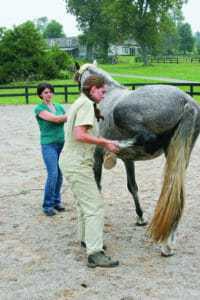
Recognizing a Club Foot: Foals to Adults (AAEP 2012)
Horse owners and veterinarians can identify a club foot based on classic signs and grades of severity.


Horse owners and veterinarians can identify a club foot based on classic signs and grades of severity.

One vet says an active veterinarian-client-patient relationship is needed to provide the best care for horses.

One vet says radiographs can help in assessing a horse’s feet and developing a plan to maximize soundness.

Owners of laminitic horses can speak with their veterinarian about registering to be included in the study.

While PHF has a serious clinical impact on affected horses, some parameters are associated with survival.

One vet says the best way to ensure equine welfare is “through a synergism of law, morals, and ethics.”

Safety in the workplace is as important in veterinary medicine as anywhere else.

A double dose of the drug proved no more effective than a single dose and presented a higher toxicity risk.

Dieken said If veterinarians can effectively influence their communications they’ll have clients for life.

These lumps and bumps can mean trouble, but researchers are making headway in defining treatment strategies.

A look at what it really costs to own a horse besides the initial purchase price.

Treatment of mares with oral gallium nitrate significantly reduced fecal concentrations of virulent R. equi.

Treatment of mares with oral gallium nitrate significantly reduced fecal concentrations of virulent R. equi but had no detectable impact on airborne concentrations, one researcher concluded.

Colic survival rates have improved greatly over the years, but timely treatment and diligent aftercare still a

Fluphenazine, a human antipsychotic drug, has drawbacks that often preclude its use in horses.

Vets examined upper airway obstruction in horses being ridden and when displaying “normal” head carriage.
Stay on top of the most recent Horse Health news with